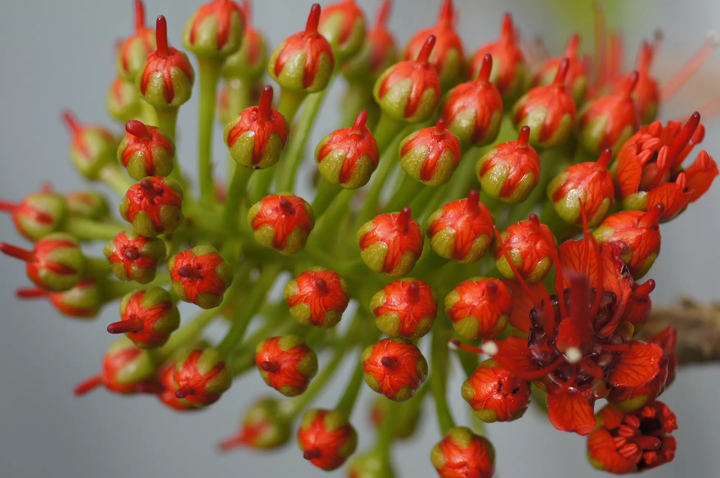The Clerodendrum paniculatum earned its common name, the pagoda plant, from its large bunches of orange-red flowers that resemble the shape of pagoda structures—common to southeast Asia where this plant originates.
Native to the Philippines, southern China, and Sri Lanka, among other lush, tropical locales, the pagoda plant thrives in regions with warm temperatures, plenty of sunshine, and abundant moisture.
These plants grow quickly and can climb to heights of three to five feet in a single year. They’re not considered invasive, but do spread by means of rhizomes, so watch for spreading suckers.
Botanical Name:
Clerodendrum paniculatum
Common Name:
Pagoda plant
Plant Type:
Tropical perennial
Mature Size:
4 to 6 feet tall and 2 to 3 feet wide
Sun Exposure:
Full to part sun
Soil Type:
Moist, well-draining
Soil pH:
Acidic
Bloom Time:
Summer
Flower Color:
Orange-red
Hardiness Zones:
8 to 11
Native Area:
Southeast Asia

How to Grow Pagoda Plants
To successfully grow a pagoda plant, choose a sunny yet sheltered location. Be sure that the soil is well-draining, since this plant will take in plenty of water during its growing season but doesn’t like to be bogged down.
Pruning at the end of the blooming season will help this plant grow to its full potential as a bushy, flowering shrub. In the winter, your perennial will either die back completely or will maintain its green foliage in evergreen fashion—if the temperatures stay warm enough.
Aphids, spider mites, and whiteflies can sometimes plague pagoda plants. Its recommended that you regularly check the leaves to ensure that you’re not facing an infestation. If you do, a mild insect soap can help to remedy the situation.
Light
The pagoda plant appreciates plenty of sunshine but also needs some protection in areas where the sun is especially intense. These plants prefer full sun in the mornings, but do best when they have partial shade in the afternoon.
Soil
These plants do best when positioned in well-draining soil. They prefer moist soils, especially during the growing season, but it won’t fare well if the soil is boggy. Pagoda plants prefer acidic soils, with a pH in the range of 5.5 to 6.0.
Water
These plants will need a regular watering routine, especially during the hot summer months and if rainfall is inconsistent.
During the blooming season, plan to water this plant at least every week, although container plants may require several waterings a week. The aim is to ensure that the top two inches of soil retain moisture, although keep in mind that drainage is still important so that root rot doesn’t become a problem.
In the winter, you only need to occasionally water if the soil becomes dry or rainfall has been inconsistent. Too much moisture during the dormant period can prove detrimental to the health of the pagoda plant.
Temperature and Humidity
Native to the lush, warm regions of southeastern Asia, it’s no surprise that the pagoda plant prefers steamy environments over cool climates. At the same time, too much heat can spell disaster for these plants. They love sun, but need a break if the rays are intense.
The pagoda plant acts like an evergreen in especially warm, tropical climates and will retain its foliage all year long. In anything cooler than such tropical regions, this perennial will die back during winter before re-emerging in the spring. If winter temperatures consistently fall below freezing, the pagoda plant may not survive at all and will need replanting each year.
Fertilizer
The fast growth and lush foliage and flowers of the pagoda plant require soil that is rich in nutrients. If your soil is lacking, then it may be necessary to supplement this plant with fertilizer, especially during the growing season.
Pay attention to the type of fertilizer you feed your plant and choose one specifically formulated for acidic soils.
Nitrate nitrogen will raise a soil’s pH level, which isn’t ideal for the pagoda plant. Instead, an acid-forming fertilizer uses ammonium or urea nitrogen to contribute the nitrogen needed while maintaining acidic pH levels.
Potting and Repotting
While pagoda plants are most commonly planted directly in the ground, you can choose to plant them in a pot. One advantage to potting a pagoda plant is the ability to control the reproduction of this plant through rhizomes.
If you do pot the pagoda plant, keep in mind its need for fertile, well-draining soil. Water frequently, especially during summer months and plan to fully repot this plant about every two years to maintain soil nutrients.
Propagating Pagoda Plants
It’s worth noting that the pagoda plant produces only sterile flowers; it’s not a seeding variety. Instead, these plants reproduce through rhizomes. While the offshoots typically appear in close proximity to the parent plant, some gardeners become exasperated trying to track down and dig up new offspring.
If you want to propagate the pagoda plant, you can use either root or stem cuttings. Another option for larger, well-established pagoda plants is division.
Toxicity of Pagoda Plants
The pagoda plant is not considered to be a toxic species, for humans or animals. Keep in mind, however, that this is also not considered an edible plant. Ingesting this plant could cause digestive discomfort and upset.
Pruning
You should plan to prune the pagoda plant as the flowering season begins to draw to a close. When the blooms begin dropping to the ground, it’s time to cut this plant back to about half of its height.
While doing so may seem drastic, failing to do so produces a tall, gangly plant with few leaves or flowers except at the top of the plant. By pruning the pagoda plant, you’ll encourage it to grow in a bushier, fuller fashion.